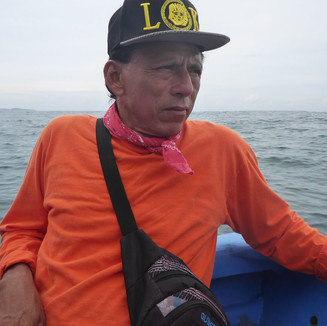Installing Radio Transmitters and the First Marks of Field Work
- Chris
- Jul 17, 2017
- 3 min read
We started to install VHF radio transmitters onto females off the coast of Ostional that have just been done with mating for the season and will hopefully start nesting soon.
We usually look for couples in the water than dive over and check, by looking under the skirt of the couples, if they are done with the actual “deed” and the male just hangs on for good measures to prevent other males from copulating with his female. If this is the case, we separate the two and take the female onto our research boat, which is chartered from a close-by artisanal fishing community.
Once the female is out of the water, we are taking a blood sample (to later determine her hormone levels), take ultrasound images of her ovaries and oviducts (to see if she has follicles and/or shelled eggs), an ultrasound image of her fat deposits (to determine nutritional state), take morphometric measurements, and then clean the carapace to install a VHF radio transmitter with a special epoxy, paint her and tag her with two external metal tags, to later find her again among hundreds of thousands of other nesting females on the beach. It is a bit like finding a needle in a hay stack and these females are our golden eggs.
For those of you that have been following our blog and my FB page you might have been able to follow us live for one of our captures on the boat and if not, HERE and HERE are the two live videos that we did on July 11th.
We have been able to install all of our 10 radio transmitters in the meantime and have painted an additional 20 females with non-toxic, lead-free paint (the kind you use for children’s toys), and now we are anxiously awaiting the first arribada to see if we can find our turtles again.
To make sure that our radio transmitter work and our females are still swimming close to Ostional we have commenced to climb a close-by hill where we have an unobstructed view onto the entire beach of Ostional and Nosara.
What else happened in the days since our last blog post? Hunter and Brie had their birthdays, and to celebrate the two and our hard work on the boat, we made a weekend trip to Samara to relax and rest a bit and to get our party pants out. We were able to meet up with another group of scientists, partially also from Texas A&M, that are working in Monteverde at the UGA campus . Jordan Rogan is conducting her PhD on small mammals, and is also part of the Applied Biodiversity Science (ABS) program that I am part of as well. If you are interested to know more, check out their blog HERE.

A hefty 24h stomach bug has been going around in Ostional ever since we arrived, and poor Hunter happened to fall sick the first night in Samara, where he was suffering for a long night instead of celebrating his birthday. Luckily, he felt better by midday the next day and was able to enjoy the rest of our stay.
On a side note, the field is already starting to leave its marks on our body. After I got cut up a bit in the reef, while getting a little bit too excited about a huge school of surgeon fish, and everyone has scratches from turtle nails all over their body (Stephanie particularly enjoys that one), Hunter’s sunscreen rubbed off on his left hand during our first days on the boat and received a second degree burn on his hand. This is mentioned here to function as a learning example, so people don’t underestimate the strength of the sun in the tropics. After initial hopes for a tan from the boat, Hunter (thankfully) gave up and started to cover himself more and more. I call it jokingly the natural selection among marine biologists.





















































































I’ve tested many online cricket betting apps, but Khelraja’s app is my favorite. It’s fast, easy to use, and works smoothly even during live matches. I never miss a betting opportunity, and the app keeps me updated with scores and odds. It’s perfect for cricket lovers who want to bet on the go.